Texas Instruments Bundle
How did a seismic data provider become a tech titan?
From its humble beginnings in 1930, Texas Instruments (TI) has etched its name into the annals of technological innovation. The company's journey, starting as Geophysical Service Incorporated (GSI), is a testament to visionary leadership and a relentless pursuit of groundbreaking advancements. This Texas Instruments SWOT Analysis will uncover the secrets behind TI's enduring success and its pivotal role in shaping the modern world.
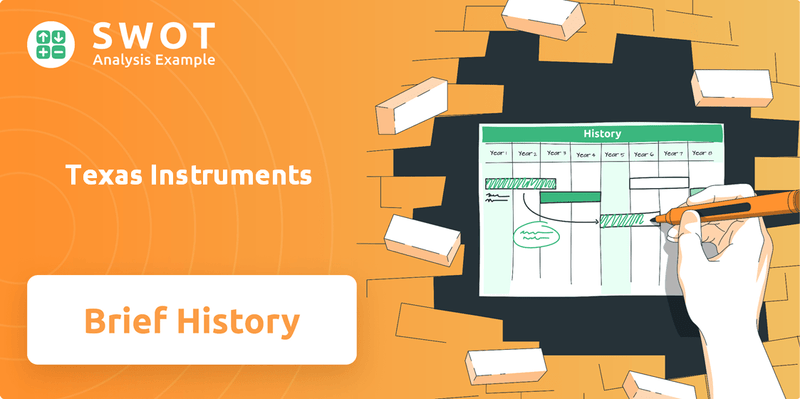
The TI history is a compelling narrative of adaptation and ingenuity. From its early days in oil exploration to its dominance in the semiconductor industry, Texas Instruments company has consistently redefined the boundaries of what's possible. This article will explore the brief history of Texas Instruments, unveiling its key milestones, TI founder's vision, and the lasting impact of its TI products and technologies.
What is the Texas Instruments Founding Story?
The story of Texas Instruments (TI) begins with Geophysical Service Incorporated (GSI), established on May 16, 1930, in Dallas, Texas. This company, the direct precursor to what would become a global technology leader, was founded by John Clarence 'Doc' Karcher and Eugene McDermott. Their initial focus was on revolutionizing oil and gas exploration using reflection seismograph technology.
GSI pioneered the use of signal processing to detect underground geological structures, offering these exploration services to the oil industry. This early innovation laid the groundwork for future technological advancements. The company's trajectory was significantly altered by World War II and the subsequent shift into the defense sector.
In 1941, four managers, including Eugene McDermott, Cecil Green, J. Erik Jonsson, and H.B. Peacock, acquired GSI for $300,000. The company's involvement in defense, particularly developing submarine detection equipment for the U.S. Navy, marked a pivotal change. Patrick Haggerty joined in 1945, eventually leading the Laboratory and Manufacturing (L&M) division.
The early history of Texas Instruments is marked by innovation in geophysics and a strategic pivot into electronics. This shift was crucial for the company's long-term success.
- GSI, the predecessor to Texas Instruments, was founded in 1930.
- The company's focus shifted from geophysical services to electronics, driven by defense contracts and the vision of leaders like Patrick Haggerty.
- The name change to Texas Instruments Incorporated in 1951 reflected a broader scope beyond geophysical services.
- The company's growth was fueled by defense contracts and the vision to enter consumer electronics.
By 1951, the L&M division's growth surpassed GSI's geophysical operations. This led to a company reorganization and a new name: Texas Instruments Incorporated. This rebranding, driven by the vision of leaders like Haggerty, signaled a move towards consumer electronics and the emerging semiconductor market. This strategic shift was a key factor in the company's long-term success and its impact on technology. For insights into the company's ownership and financial structure, you can explore Owners & Shareholders of Texas Instruments.
Texas Instruments SWOT Analysis
- Complete SWOT Breakdown
- Fully Customizable
- Editable in Excel & Word
- Professional Formatting
- Investor-Ready Format
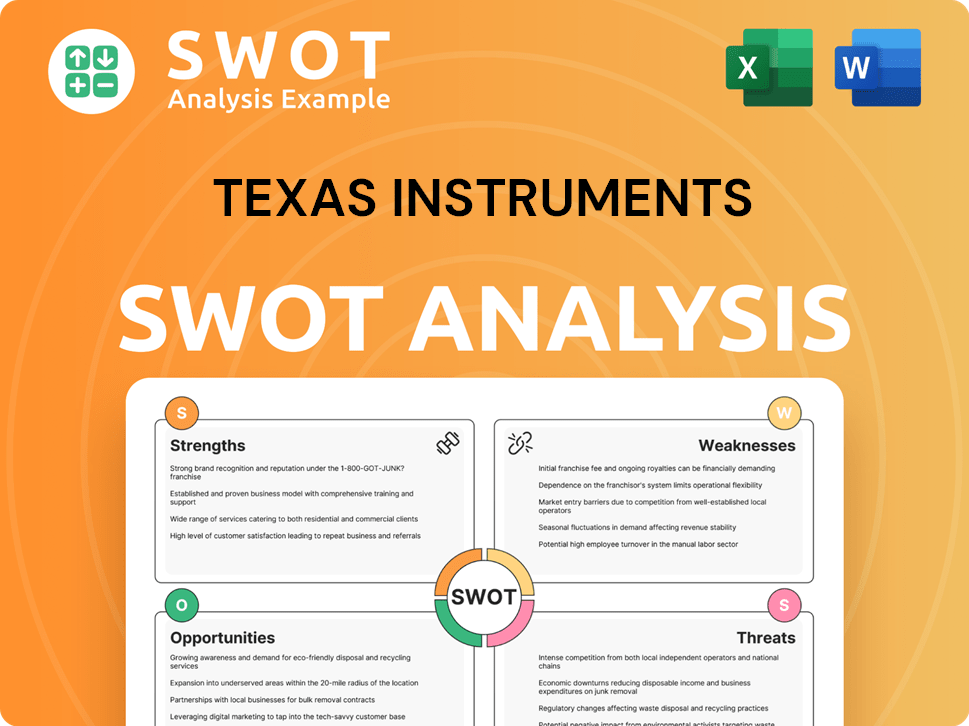
What Drove the Early Growth of Texas Instruments?
Following its renaming to Texas Instruments in 1951, the Texas Instruments (TI) company rapidly expanded and innovated. This period saw the company establish itself as a leader in the semiconductor industry. The company's strategic moves and technological breakthroughs during this time significantly shaped its future. This era marked the beginning of Texas Instruments' journey as a major player in the global technology market.
A pivotal moment in TI history came in 1954 when the company designed and manufactured the world's first commercial silicon transistor. In the same year, it developed the first transistor radio, the Regency TR-1. This initiative, led by Patrick Haggerty, aimed to boost market demand for transistors. The introduction of these products showcased Texas Instruments' commitment to innovation.
On October 1, 1953, TI's stock was listed on the New York Stock Exchange, a significant step in its financial growth. This move provided the company with greater access to capital and enhanced its visibility in the investment community. The company's strategic focus on semiconductors deepened with the invention of the integrated circuit (IC) by Jack Kilby in 1958. This was a major technological advancement.
The invention of the integrated circuit (IC) by Jack Kilby in 1958 was a monumental leap, consolidating multiple electronic components onto a single silicon chip. This innovation streamlined electronics manufacturing and paved the way for smaller, more powerful devices. TI continued to expand its product portfolio, introducing the first single-chip microcontroller in 1970, which integrated all computing elements onto one piece of silicon.
Throughout its early growth, TI demonstrated an ability to adapt to market demands and leverage its technological advancements. The company's commitment to internal manufacturing capabilities, including its vertically integrated business model (IDM), allowed it greater control over its supply chain and costs. This approach has been a cornerstone of its strategy, enabling it to deliver high-quality chips efficiently. For more insights into the company's financial strategies, consider reading about the Revenue Streams & Business Model of Texas Instruments.
Texas Instruments PESTLE Analysis
- Covers All 6 PESTLE Categories
- No Research Needed – Save Hours of Work
- Built by Experts, Trusted by Consultants
- Instant Download, Ready to Use
- 100% Editable, Fully Customizable
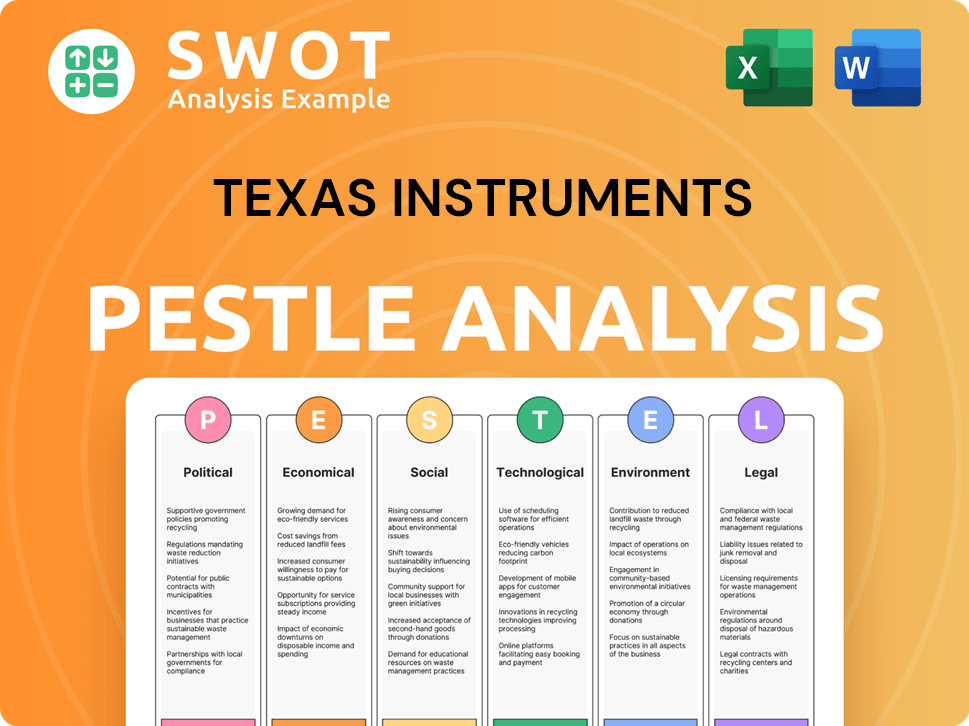
What are the key Milestones in Texas Instruments history?
The TI history is marked by significant achievements and pivotal moments that have shaped the technology landscape. From its inception, the Texas Instruments company has consistently pushed the boundaries of innovation, leaving a lasting impact on various industries. Understanding the Texas Instruments timeline is crucial to appreciating its evolution and influence.
| Year | Milestone |
|---|---|
| 1958 | Jack Kilby invented the integrated circuit, a groundbreaking innovation that revolutionized electronics. |
| 1967 | TI demonstrated the first solid-state radar and invented the hand-held calculator, transforming computing. |
| 1987 | Larry Hornbeck at Texas Instruments invented the Digital Light Processor (DLP) technology, essential for projectors. |
TI's commitment to innovation has driven significant advancements. The company's continuous investment in research and development has led to numerous TI products and technological breakthroughs.
The invention of the integrated circuit by Jack Kilby in 1958 was a pivotal moment, fundamentally changing the electronics industry. This innovation earned Kilby a Nobel Prize and laid the groundwork for modern computing.
TI's invention of the hand-held calculator in 1967 made complex calculations accessible to the masses. This TI product democratized computing, impacting education and various professional fields.
Developed in 1987, DLP technology by Larry Hornbeck revolutionized projection and digital cinema. This innovation enhanced visual experiences in various applications, from home entertainment to professional presentations.
Texas Instruments has consistently pushed the boundaries of semiconductor technology. Ongoing R&D efforts have resulted in numerous patents and advancements in chip design and manufacturing.
TI's Embedded Processing segment has been a key area of innovation, focusing on solutions for various industries. This segment provides powerful and efficient processing capabilities for a wide range of applications.
Texas Instruments has consistently innovated in analog technology, developing components that are essential for a wide range of electronic devices. These advancements improve the performance and efficiency of various systems.
Despite its successes, TI has faced challenges inherent in the semiconductor industry. The company has navigated market downturns and competitive pressures, requiring strategic adjustments.
The semiconductor industry is cyclical, and Texas Instruments has experienced periods of softening demand. In 2024, the company faced a revenue decline, reflecting the volatile nature of the market.
TI operates in a highly competitive market, requiring continuous innovation and strategic positioning. The company must adapt to evolving technologies and the strategies of its competitors, as discussed in Competitors Landscape of Texas Instruments.
TI's financial performance can be affected by economic conditions and demand in key markets. In 2024, the company's full-year revenue reached $15.641 billion, an 11% decrease compared to 2023, and net income decreased by 25% year-on-year to $4.799 billion.
Certain segments, such as Embedded Processing, have experienced significant declines. The Embedded Processing segment saw a decline of 25% in 2024, highlighting the need for strategic adjustments and focus.
TI undertakes strategic initiatives to reinforce its market position and address challenges. These initiatives include investments in R&D and a focus on high-growth markets like industrial and automotive.
Ensuring supply chain control and cost efficiency is a key challenge for Texas Instruments. Investments in 300mm wafer fabrication facilities are a strategic move to address these issues.
Texas Instruments Business Model Canvas
- Complete 9-Block Business Model Canvas
- Effortlessly Communicate Your Business Strategy
- Investor-Ready BMC Format
- 100% Editable and Customizable
- Clear and Structured Layout
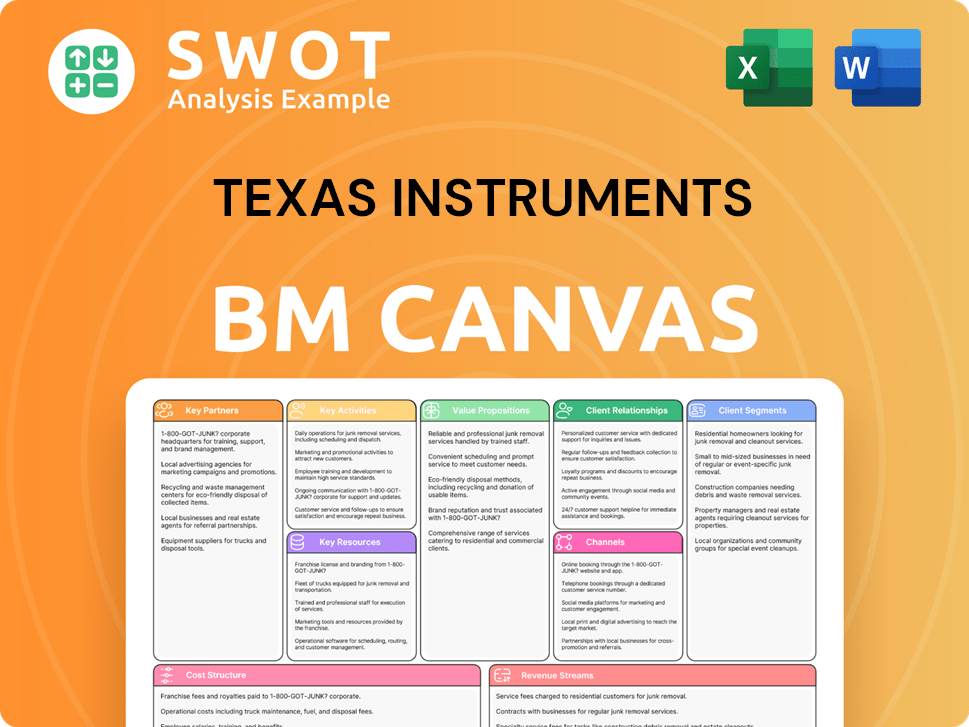
What is the Timeline of Key Events for Texas Instruments?
The Growth Strategy of Texas Instruments has been marked by significant technological advancements and strategic business decisions. From its origins in geophysical exploration to its current status as a leading semiconductor company, Texas Instruments (TI) has consistently innovated. Here's a look at the key milestones in the TI history.
| Year | Key Event |
|---|---|
| 1930 | Geophysical Service Incorporated (GSI), the predecessor to TI, is founded. |
| 1941 | GSI is acquired by Eugene McDermott, Cecil Green, Erik Jonsson, and H.B. Peacock. |
| 1951 | GSI is reorganized and renamed Texas Instruments Incorporated. |
| 1953 | TI's stock is listed on the New York Stock Exchange. |
| 1954 | TI designs and manufactures the first commercial silicon transistor and the first transistor radio. |
| 1958 | Jack Kilby invents the integrated circuit at TI. |
| 1967 | TI invents the hand-held calculator and demonstrates the first solid-state radar. |
| 1970 | TI introduces the first single-chip microcontroller. |
| 1987 | Larry Hornbeck at TI invents the Digital Light Processor (DLP). |
| 2024 | Full-year revenue reaches $15.641 billion, with net income of $4.799 billion, with the automotive market contributing about 35% of revenue, and the industrial market about 34%. |
| Q1 2025 | Revenue increases 11% year-over-year to $4.07 billion, with net income of $1.18 billion; the Analog segment revenue grew 13% year-over-year. |
| May 2025 | Texas Instruments prices a $1.2 billion offering of senior unsecured notes to fund ongoing manufacturing expansions. |
Texas Instruments is well-positioned to capitalize on the expansion in the industrial and automotive sectors. These markets are expected to drive further growth in semiconductor demand. TI's focus is on increasing free cash flow per share through its core analog and embedded processing products.
The company continues to invest heavily in manufacturing capacity. This includes the expansion of 300mm wafer fabrication facilities in both Texas and Utah. These investments are supported, in part, by the U.S. CHIPS and Science Act.
TI is committed to environmental sustainability, aiming for 100% renewable electricity in its 300mm manufacturing operations. The target is to achieve this by 2025 in the U.S. and by 2030 worldwide, demonstrating a strong focus on reducing its carbon footprint.
While some market softness is anticipated, TI anticipates continued profitability and growth in 2025. Analysts project an EPS growth of 12.6% year-over-year to $5.72. The company is also committed to returning capital to shareholders, with $6.4 billion returned over the past 12 months.
Texas Instruments Porter's Five Forces Analysis
- Covers All 5 Competitive Forces in Detail
- Structured for Consultants, Students, and Founders
- 100% Editable in Microsoft Word & Excel
- Instant Digital Download – Use Immediately
- Compatible with Mac & PC – Fully Unlocked
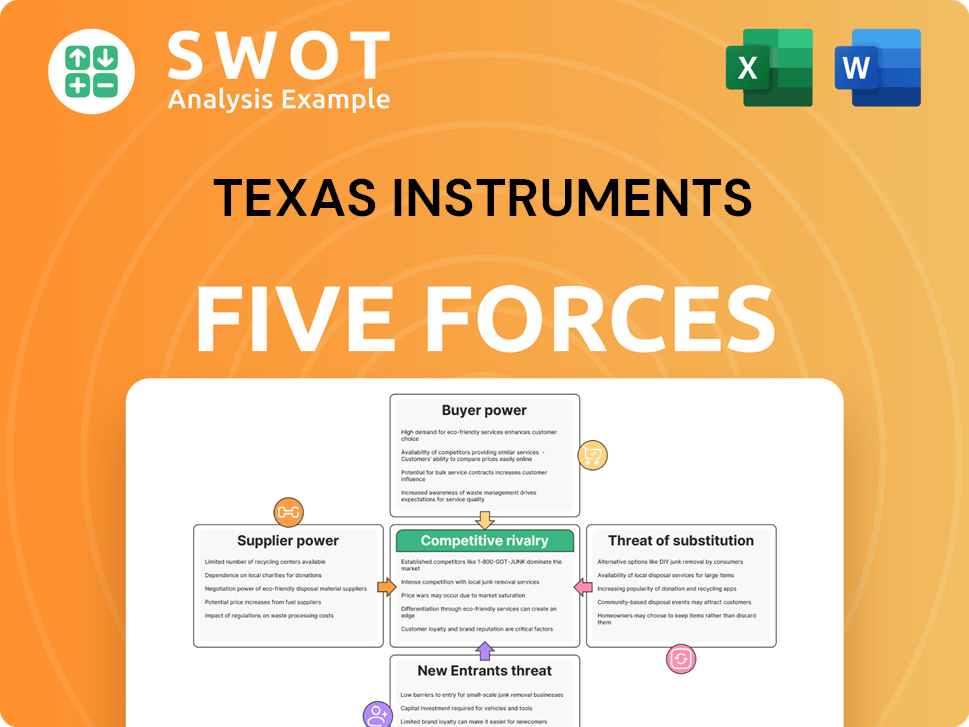
Related Blogs
- What is Competitive Landscape of Texas Instruments Company?
- What is Growth Strategy and Future Prospects of Texas Instruments Company?
- How Does Texas Instruments Company Work?
- What is Sales and Marketing Strategy of Texas Instruments Company?
- What is Brief History of Texas Instruments Company?
- Who Owns Texas Instruments Company?
- What is Customer Demographics and Target Market of Texas Instruments Company?
Disclaimer
All information, articles, and product details provided on this website are for general informational and educational purposes only. We do not claim any ownership over, nor do we intend to infringe upon, any trademarks, copyrights, logos, brand names, or other intellectual property mentioned or depicted on this site. Such intellectual property remains the property of its respective owners, and any references here are made solely for identification or informational purposes, without implying any affiliation, endorsement, or partnership.
We make no representations or warranties, express or implied, regarding the accuracy, completeness, or suitability of any content or products presented. Nothing on this website should be construed as legal, tax, investment, financial, medical, or other professional advice. In addition, no part of this site—including articles or product references—constitutes a solicitation, recommendation, endorsement, advertisement, or offer to buy or sell any securities, franchises, or other financial instruments, particularly in jurisdictions where such activity would be unlawful.
All content is of a general nature and may not address the specific circumstances of any individual or entity. It is not a substitute for professional advice or services. Any actions you take based on the information provided here are strictly at your own risk. You accept full responsibility for any decisions or outcomes arising from your use of this website and agree to release us from any liability in connection with your use of, or reliance upon, the content or products found herein.